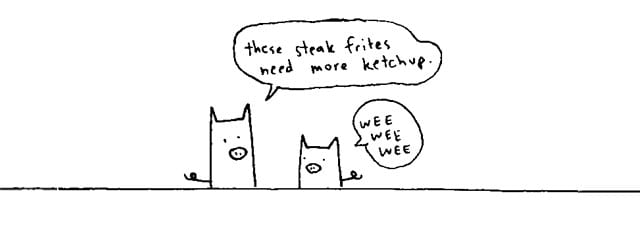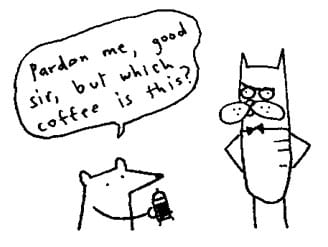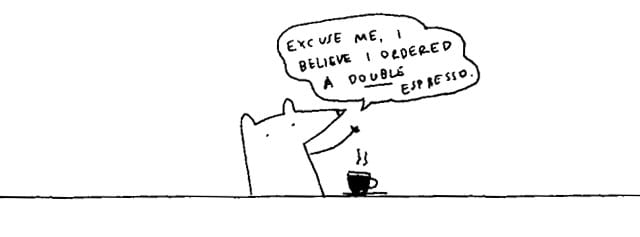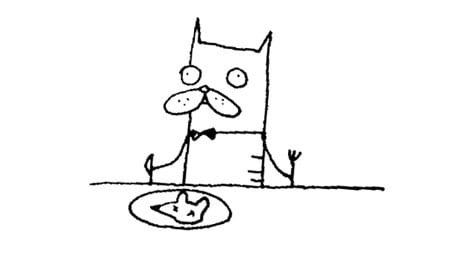
Welcome to Sprudge Confidential, a new series of long-form essays from the very best writers in coffee. This first feature comes to you from Alex Bernson, professional barista and staff writer for Sprudge.com. Watch for more Sprudge Confidential features in the coming months.?
There is something peculiar about most of the coffee one finds in airplanes and hotels. It tastes nothing like the place where you are drinking it: liminal, transient, the same everywhere, utterly forgettable and yet immensely, oddly evocative. It is non-place coffee. Fast food iced coffee is a similar experience: to me it tastes like water, milk, sugar, odd moments of the three years I lived in New England, early morning road trips and hungover emergency caffeination drug-runs.
I think non-place coffee is more prevalent and far more loved then we realize. It?s not just in chain stores, and it?s not just served to-go. The most expensive cappuccino in New York City is a non-place coffee. It?s an utterly horrendous, utterly forgettable $8 abomination of meekly frothed milk and undrinkable Illy espresso, served alongside crisps, cheese doodles, and the ghosts of the 20th Century.
There has been much discussion throughout the industry about how we can work towards the supposedly mythical $8 cappuccino. Higher price points mean a more sustainable industry for all. More money to pay for producers, importers, exporters, roasters, and even those like myself, working 60 hours a week to manage and maintain specialty coffee on the retail level. The mythical $8 cappuccino might make things easier for everyone! More money to go around, to pay at source, to pay for staff, to represent a proper and fair price point for the some of the truly extraordinary coffee experiences available to today?s knowledgeable coffee consumer. A utopia of fair price for fine product.

But the $8 cappuccino is no myth. It is available to the public 7 days a week in the Bemelman?s Bar at The Carlyle hotel. It?s the least appealing cappuccino I?ve ever had. It is a heterotopic cappuccino. A symbolic cappuccino. A cappuccino without merits of its own, defined wholly by the place where it is found. New York City?s most expensive cappuccino ? and also, its worst.

Heterotopias and Real Cappuccinos
Michel Foucault defines a heterotopia as a physical place that is tied to one or more non-real symbolic places?symbolic places that overflow the physical with meaning, imbuing the physical realities of a place with social-symbolic power to ?simultaneously reflects and contests all real places in society.? A heterotopia is an image of larger society reflected in the contours of physical place.
One of Foucault?s favorite examples is a prison: it is a physical expression of society?s non-real image of itself as rigidly and simply divided into the ?good? people and the ?evil-doers?. The actual physical nature of a prison belies the messy social construction of the idea of deviance. There are a great many evil people living quite comfortably outside of prisons, and there are a great many people living inside of prisons not because they did evil per se, but simply because the larger society forcibly defined their actions as deviant.
A heterotopia?s existence, no matter how contradictory in reality, is its own justification. No matter how innocent you might actually be, no matter how messy, socially constructed and pseudo-arbitary our ideas of deviance are, as far as society is concerned, if you are in a prison, you deserve to be there. You are a deviant.
In the same way, if you are sitting in The Carlyle Hotel having a cappuccino that costs $8, in the view of society at large, you are having a luxurious cappuccino. Even if it tastes like a bitter americano with the thinnest film of barely foamed milk on top.
This is a non-place cappuccino. An $8 Illy cappuccino. Unfortunately, an all too real cappuccino. A contradictory cappuccino. A paradox of immense price and vile quality.

Luxurious Surroundings and the Symbolic Cappuccino
The atmosphere of Bemelman?s Bar is carefully calculated to overflow with enjoyment. The bar is gorgeous, rich, warm and comfortable. It is called Bemelman?s Bar after Ludwig Bemelman, the illustrator of Madeleine, who paid for a year and a half of living at The Carlyle by covering every inch of the bar?s walls with murals of New York city scenes done in his signature whimsical style. Even the lamp shades are adorned with his art. All the little details are right, from a live piano player in the evenings, to our server?s white dinner jacket, the endlessly refilled silver trays of (delicious!) nut mix and fancy cheeze doodles, the plush leather seating, and the (actually quite delicious) $21 negroni. It all speaks loud and clear: this is a world where you pay out the nose for a luxurious experience, where catering to your enjoyment is nominally of the utmost priority.
However, the great contradiction of The Carlyle, and perhaps much of ?old-guard? luxury generally, is how little effort is put into ensuring you enjoy the actual product?s quality, compared to the effort put into making the place you consume that product seem like the kind of place where you would find its quality enjoyable. But they know they can get away with focusing on appearances.
Bemelman?s $8 cappuccino is clearly an abstract symbol?it is but one prop in the creation of their experience. The cappuccino didn?t appear on my bar tab when we settled up, I can only assume because I had obviously taken at most two sips of it, and at a place like The Carlyle the server was not going to charge me for something I hadn?t enjoyed.

Reflections in French-Press Cages and Cut-Glass Ketchup Bowls
I had a horrendous contradictory $8 cappuccino in a luxurious bar. That could perhaps be said to be an understandable coffee anachronism. However, the $32 I spent on two french presses and an espresso during tea service at The Carlyle goes far beyond a lazy contradiction. I found the hollow image of society reflected in that tea service to be painful, and absurd, and altogether poignant
I had actually come to The Carlyle specifically for the tea service, dragging my friends Sam Lewontin and Angus McCullough along for their conversational insight. The tea menu online promised two different single origin french press offerings from Lavazza, a Ethiopia Yirgacheffe and a Costa Rica La Minita, and a selection of Illy espresso beverages. To be honest, I was actually the most excited by the prospect of scones with Devonshire cream?a treat that I had sampled once ages ago at a proper high tea in Bath, England, an experience that is still the pinnacle against which all scone and butter- related experiences are measured for me.
The actual experience of tea at The Carlyle was thoroughly odd, very well appointed, poorly served, largely unappetizing, depressingly lacking in the scone department, and utterly mediocre in the coffee department. Beautiful and unacceptable.
Tea was served in The Gallery, an intermediate space connecting the bar and the dinning room to the rest of the hotel. We sat in the lower gallery, which The Carlyle describes as full of ?Exotic, elegant d?cor by legendary decorator Renzo Mongiardino ? [featuring] an intricate blue-and-gold wallpaper, inset with intaglio-like views of such landmarks as Venice?s Church of the Saulte and Istanbul?s Hagia Sophia?. It?s a small space, with over-stuffed with tables and richly upholstered banquettes, oval shaped in such a way that when we sat at a low table in one corner, we could perfectly clearly overhear the conversation of the party seated across the room from us.
Once you squeezed in-between the densely packed furniture and settled yourself on the banquette, the d?cor was indeed elegant, and I don?t know that it?d be possible for the table linens to have a higher thread-count. I felt comfortably ensconced in luxury, and yet the strange acoustics, elegant china and extreme proximity of other guests made it feel oddly necessary to keep our conversations quiet and our movements reserved. A physical imposition of a delicate social sensibility.
Our fellow guests at tea were out of the Luxury Department of Central Casting. At the other end of the room were four New Yorkers, identifiable by the women?s all black cashmere ensembles and perfect dye-jobs, and by the men?s colossally expensive business suits that were slightly ill-fitting in that peculiarly American way. Seated next to us were three completely interchangeable early 30s German men of the sort that can be found in every luxury hotel, restaurant and bar the world over: expensive jeans, well-fit sweaters, heavy gold watches, identical swept back hair cuts, and louche, boyish demeanors. The pi?ce de r?sistance was the perfectly eccentric older gentleman having tea by himself and scribbling away in his notebook in that way that seems so fitting for a nattily dressed man with big silver hair that bordered on pompadour territory, with chunky artistic glasses, exuberantly matched orange corduroy pants, an Aztec-patterned blazer, a maroon knit tie and a bright blue and white polka-dot pocket square.
In such refined surroundings, the bumbling and incompetent nature of our servers seemed particularly odd. Sure, they served from the left, cleared from the right and were obsequious, but there was no air of attentive reserve and concern?we had to flag them down for our order and check; the food and drink was dropped without announcement; though we said we would be sharing, when the second french-press was served I had to ask for a second cup; and when we asked which french press was which coffee, they had to go check and came back with a hasty and mumbled answer.

I?m not sure how to explain the odd service. I watched a number of other guests also have to intervene and ask for service needs that should have been anticipated. Maybe the type of people that regularly frequents places such as The Carlyle actually like to have to order their service staff around. Maybe it was just the B team working that day.
The service may have been odd, but the product was surprisingly, consistently bad. The two scones we received for $18 were tiny, only four bites in total, and dry, served with ?devonshire cream? that was little more than hard, somewhat sweet butter. The tea sandwiches were the most passable portion. Angus had a lapsang suchong tea that he informed me was Twinnings. As for me, well, maybe I should have known better than to get coffee at teatime. My double espresso was at least 3.5 ounces, bitter, with just the barest hint of caramel body. The two french-presses tasted identical: watery, hollow, sharp?over-roasted, under-dosed and ground too finely, probably hours if not days ago.
The coffee product may have been terrible, but the device itself was Bodum?s most elegant chrome-caged press pot model, spotlessly polished. The cups and saucers were beautiful china in a rich Victorian pattern. The sugar packets were emblazoned with the Carlyle coat of arms; and the solid silver pitcher I used to pour cream into my coffee (a necessity) had an immensely pleasing weight in my hand.
Yet when I added that milk and sugar to my coffee?experiencing the coffee as I imagine most of their guests do?the taste went from unpleasant to merely bland. Unremarkable. Exactly like a chain store to-go iced coffee in a 32 ounce plastic cup.
As I sat there drinking my non-place coffee, I watched the Germans next to me be served perhaps the saddest steak frites I have seen. Miniscule cuts of beef, a pile of what looked like pre-frozen french fries, accompanied by a solid silver gravy boat of b?arnaise sauce. They drowned their sorrows in a pool of ketchup, what must have been 8 ounces of it, served in an elegant cut glass bowl. The effect was haunting in its quiet desperation.
It felt like The Carlyle didn?t even try. Thankfully I had been given a research budget to offset some of the price of this luxury mediocrity, because otherwise I would have been incensed. Perhaps that?s why the other guests seemed to suffer these indignities willingly; when money is no object, what does it matter if you aren?t getting what you pay for.
Or maybe the other guests that day believed they got exactly what they paid for: a luxurious teatime appropriate to their social station. The price certainly defined it as uncommon, rarefied. The surroundings were gorgeous. The location was on a prestigious street on the right side of the Park. The tablewares probably costs twice my monthly rent. And if you don?t know better, or don?t care, the products they serve at They Carlyle aren?t exactly offensive, just unremarkable.
Those horribly mediocre french-presses we had were their own little microcosms of society. Luxury is not how it tastes, it?s the china pattern it?s served in. At least for many in the segment of society willing to pay the truly luxury prices.

Absorbing Symbolism
The across the board mediocrity of The Carlyle shows that luxury can be largely a feeling one has in a place, not an impression one gets from a taste experience. This is particularly true for coffee, where many consumers are still uniformed and tolerant of low quality. Still, I don?t think that is enough of an explanation for the truly bad coffee I had at The Carlyle.
I think coffee, especially bad coffee, is one of the most heterotopic products. It is empty yet evocative; it sucks up symbolism. A cup of coffee is the background for so many places and experiences in life, it can contain so many different worlds. When so much of the coffee consumers drink tastes like no place in particular, symbolism is free to attach irrespective of what is actually in the cup.
This is how the cappuccino at The Carlyle is able to be classified as luxurious. The quality of cappuccino and its price is contradictory on its face. But for certain people, this contradiction is hardly noticed, because they simply don?t care or don?t know any better. They are far more concerned with the symbols of luxury around them?the address, the history, the design, the materials, the other patrons, the ambiance, all of which The Carlyle has in spades.
These symbols create a social world unto themselves, one where contradictions like a terrible $8 cappuccino are hardly noticed. In this world of $18 mini-scones, existentially depressing steak frites and inept but obsequious servers, yet another service establishment offering bad coffee is hardly the most noteworthy example of how society?s idea of luxury can at times be arbitrary, or concerned with appearance over substance. Yet, people still pay incredible sums of money for The Carlyle?s version of luxury, and don?t seem to bothered by the contradictions.
How sad though that the cup of coffee that most people experience, the physical lens on so many moments of their worlds, is so mediocre, so unnoticed. Non-place coffee is so prevalent that even when people have an amazing cup of coffee, they often are unable to see past their commodity view to see how that cup tastes like the tasteful environment in which it is presented and the care put into it by highly trained specialists ? baristas, I mean.
There will always be a place for cheap, non-place coffee. A lack of differentiation is how people want their world to be sometimes, and that is fine. But anyone who has worked for a barista wage knows that our market needs greater differentiation, that to have coffee professionals dedicated to making truly noteworthy cups, we need to create places where they can charge sustainable amounts that reward their dedication.
In Conclusion
A horrendous cappuccino is able to absorb enough of an air of luxury from The Carlyle?s china and marble and silver that they can charge $8 for it. If that can be done with a cup of mediocre non-place coffee, it should be doable with a truly luxurious, carefully crafted, eminently place specific coffee.
A cup of coffee is heterotopic. It reflects and absorbs symbolism. This lets The Carlyle?s of the world manipulate symbols of luxury and get away with charging $8 for a terrible cappuccino. Specialty coffee needs to acknowledge and grab a hold of that symbolism, because while the industry is good at focusing on what goes in the cup, we aren?t always great at what goes on outside the cup. The $8 cappuccino is a real thing, not mythic, and it?s a fair thing for the industry to strive for. It?s just that someone else is getting it wrong first.
We need to reclaim this supposedly mythic price point. We need to bend its symbolism of luxury to our own, to a fuller and more tangible vision of true quality in the cup. One we earn by creating an informed customer base, happy to sometimes go beyond their every-day coffee for a truly remarkable $8 experience. An experience of luxury inside and out.

Alex Bernson is a staff writer for Sprudge.com.
Doodles by Sprudge co-founder and managing editor Zachary Carlsen.
Source: http://sprudge.com/sprudge-confidential-coffee-and-cataclysm-at-the-carlyle-hotel.html
pasco county rooney mara solstice x factor results x factor results the hobbit movie trailer xfactor
No comments:
Post a Comment
Note: Only a member of this blog may post a comment.